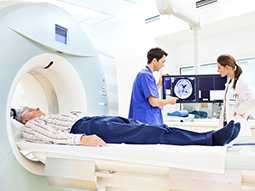Kyphoplasty is a minimally invasive procedure to treat vertebral compression fractures (VCF) in the spine that often result from osteoporosis or spine trauma. To eliminate debilitating pain caused by compressed vertebrae, kyphoplasty uses a cement mixture to reinforce fractured vertebrae, strengthening the spine for immediate pain relief and prevention of future fractures.
Why kyphoplasty is performed
If you have severe pain in the spine as a result of fractured vertebrae, you may need kyphoplasty to minimize your discomfort without the use of pain medication or braces. Kyphoplasty is often performed on patients who:
-
Suffer from osteoporosis
-
Are elderly and experience a fall or other trauma
-
Have a malignant tumor that causes vertebral compression
How to prepare for kyphoplasty
Before your kyphoplasty procedure, your interventional radiologist will evaluate your spine using an MRI, bone scan, or computed tomography (CT) scan to see the location and severity of your fracture. Be sure to provide a list of your current medications as some may need to be stopped prior to the scheduled procedure, including blood thinners.
Your care team will communicate any restrictions on eating and drinking prior to your appointment time. Because you will receive sedation during kyphoplasty, be sure to arrange for a ride home.
Risk and benefits of kyphoplasty
Kyphoplasty is a safe procedure with many benefits. Most importantly, the treatment approach has high success in relieving debilitating pain caused by fractured vertebrae. As a result, most patients are able to return to their previous level of physical activity without the use of pain medication or rehabilitation. In addition, kyphoplasty is a minimally invasive procedure requiring only a small nick, so recovery is safer and faster than traditional surgery.
Like all medical procedures, kyphoplasty does carry some small risks, including bleeding, infection, and numbness. On rare occasions, a small amount of the cement mixture may leak out of the vertebrae, but this does not usually present a serious problem. The use of imaging guidance helps your care team to reduce these risks as much as possible.
What to expect during kyphoplasty
Post kyphoplasty
After your kyphoplasty procedure, you may feel immediate pain relief although the incision site may be sore for a few days. If your procedure was completed as an outpatient procedure, you may be allowed to go home the same day. However, if you were admitted to the hospital for a trauma or other serious event, you may spend the night in the hospital as you recover.
Many patients are able to resume normal activities within a few days and your care team will contact you regularly to monitor the effectiveness of the treatment.
Our providers

Expert interventional radiology care
Getting the care you need starts with seeing one of our interventional radiologists.









